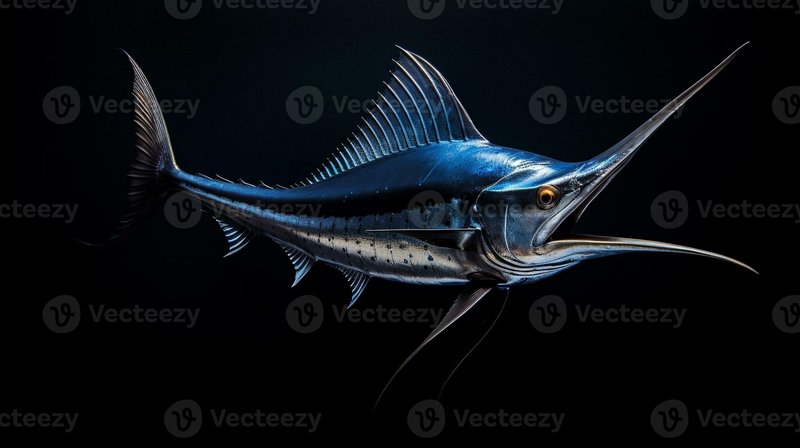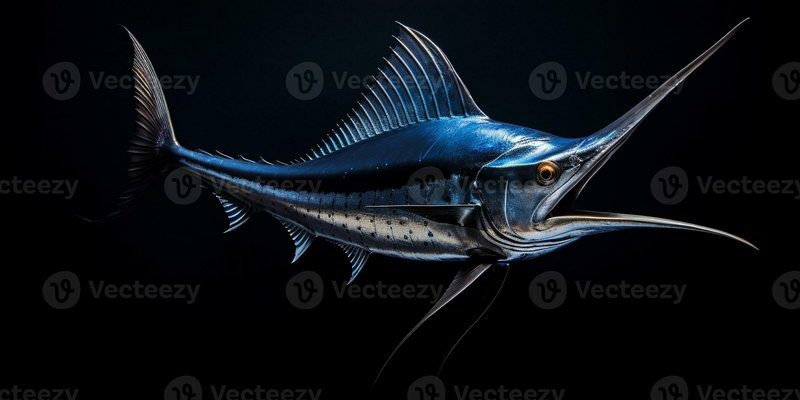
Swordfish are fascinating creatures that glide through the ocean with elegance and power. Imagine a sleek, streamlined fighter jet cutting through the water—that’s how a swordfish moves. With their long, pointed bills, they are often seen as the ultimate hunters of the sea. These magnificent fish can reach impressive lengths, making them one of the largest predators in their habitat. But there’s so much more to these incredible fish than just their size.
You might be wondering about their behavior, diet, and just how they fit into the ocean’s ecosystem. Well, swordfish are more than just impressive athletes; they play a crucial role in maintaining the balance of marine life. From their unique adaptations to their intriguing hunting techniques, let’s dive deeper into what makes swordfish so special.
Characteristics of Swordfish
Swordfish are notable for several unique features. One of the most striking characteristics is their elongated, flat bill, which resembles a sword—hence the name. This bill isn’t just for show; it’s a powerful tool used to slash through schools of fish, stunning them and making them easier to catch. The body of the swordfish is equally impressive, with a streamlined shape that allows for swift movement through the water.
A mature swordfish can reach lengths of up to 10 feet and weigh around 1,200 pounds. They can also swim at speeds of up to 60 miles per hour, making them one of the fastest fish in the sea. The combination of their size, speed, and hunting prowess makes them a formidable predator.
Physical Attributes
The skin of a swordfish is another fascinating aspect. It is tough and covered with small, tooth-like structures called dermal denticles, which reduce drag as they swim. This adaptation allows them to move efficiently through the water, further enhancing their hunting capabilities. Additionally, swordfish are dark blue on top and silver on the bottom, which provides them with camouflage against predators and prey alike when viewed from above or below.
Life Cycle
Swordfish have a relatively complex life cycle. They are capable of spawning multiple times a year in warmer waters. The eggs hatch into larvae, which drift in planktonic waters for several months before settling into deeper ocean layers. During this juvenile stage, swordfish grow rapidly, taking advantage of abundant food resources. As they mature, they transition into different habitats, often migrating long distances to find the best feeding grounds.
Habitat and Distribution
Swordfish are found in temperate and tropical seas worldwide. They prefer deeper offshore waters, often dwelling at depths between 300 to 1,500 feet. These depths provide them with the right conditions to hunt effectively. During the day, they typically remain deep below the surface but rise closer to the water’s surface at night to hunt.
Their adaptability to different oceanic environments makes them prevalent in various regions, including the Atlantic, Pacific, and Indian Oceans. This broad distribution is both a strength and a vulnerability, as they face threats from overfishing and habitat loss in certain areas.
Migration Patterns
Swordfish are known for their migratory behavior. Depending on the season and water temperature, they travel thousands of miles. This migration is often associated with their search for food and optimal spawning conditions. These journeys are crucial for their survival, especially as they seek out schools of prey like mackerel, squid, and other fish.
Feeding Habits
As carnivorous predators, swordfish have a diverse diet. They typically hunt alone or in small groups, relying on their speed and agility to catch fast-moving prey. Their long bills give them an advantage, allowing them to slash at schools of fish, stunning them for easier consumption. Interestingly, their hunting strategy can change based on the availability of food, showcasing their adaptability as predators.
Conservation Status
Despite their impressive abilities, swordfish populations have faced significant pressure due to overfishing. They are often captured unintentionally through bycatch in fishing nets targeting other species. In some regions, their numbers have declined sharply, leading to stricter regulations to help them recover.
Efforts are underway globally to promote sustainable fishing practices. These initiatives aim to ensure that swordfish populations remain healthy and that they can continue to thrive in their natural habitats. By raising awareness and advocating for responsible fishing, we can contribute to their conservation efforts.
Threats to Survival
In addition to overfishing, swordfish face threats from climate change, which affects their migratory patterns and breeding grounds. Warmer ocean temperatures can impact their food sources and lead to shifts in their population dynamics. As these changes continue, it’s crucial to monitor and adapt conservation strategies to protect this magnificent species.
How You Can Help
You can play a role in swordfish conservation efforts by supporting sustainable seafood choices. Look for seafood with certification labels that indicate responsible fishing practices. Additionally, advocating for policies that protect marine ecosystems can further help in preserving not only swordfish but the entire oceanic environment they inhabit.
Interesting Facts About Swordfish
| Size: | Up to 10 feet long |
| Weight: | Can weigh over 1,200 pounds |
| Speed: | Can swim up to 60 mph |
| Habitat: | Temperate and tropical ocean waters |
| Lifespan: | Around 4 to 7 years in the wild |
| Diet: | Carnivorous, primarily feeding on squid and fish |
| Conservation Status: | Vulnerable due to overfishing |
FAQ
What is the typical lifespan of a swordfish?
Swordfish typically live around 4 to 7 years in the wild. However, factors like environmental conditions, food availability, and threats from predators can affect their lifespan. Some swordfish may live slightly longer if they avoid fishing pressures.
Are swordfish dangerous to humans?
While swordfish are powerful predators, they are not dangerous to humans unless provoked. Their long bills can cause harm, but they rarely engage with humans. They tend to swim away when encountered, making them more of a fascinating species to observe than a threat.
How do swordfish reproduce?
Swordfish are capable of spawning multiple times each year in warmer waters. Females release eggs into the ocean, where they are fertilized by males. This spawning process can lead to large numbers of offspring, which are crucial for maintaining their population levels.
What other fish are related to swordfish?
Swordfish belong to the family Xiphidae, which also includes marlins and sailfish. These species share similar body shapes and hunting strategies, making them relatives in the diverse world of marine life. They all exhibit unique adaptations that help them thrive as top predators in their respective environments.
Can swordfish change color?
While swordfish do not change color dramatically like some other fish species, they can exhibit slight variations based on their environment and stress levels. Their bluish backs and silver bellies help them blend into their surroundings, providing camouflage against both predators and prey.
What do swordfish eat?
Swordfish are carnivorous and enjoy a diet primarily consisting of squid, mackerel, and other fast-moving fish. They use their speed and agility to hunt effectively, often employing their long bills to stun their prey before consumption.
Are swordfish good to eat?
Many people enjoy swordfish for its firm texture and mild flavor, making it a popular choice in seafood dishes. However, it’s important to consider sustainability when consuming swordfish. Some populations are overfished, so choosing sustainably sourced options is crucial for preserving the species.
How fast can a swordfish swim?
Swordfish are incredibly fast swimmers, capable of reaching speeds of up to 60 miles per hour. This impressive speed is a key factor in their hunting strategy, allowing them to chase down swift prey successfully. They are truly among the ocean’s fastest swimmers.
Do swordfish have any natural predators?
While adult swordfish are apex predators, they can be vulnerable when they are young. Larger sharks, orcas, and even humans can pose threats to younger swordfish. However, once they reach maturity, their size and speed typically keep them safe from most predators.
What is the biggest swordfish ever recorded?
The biggest swordfish ever recorded weighed approximately 1,430 pounds and measured about 12 feet in length. Such remarkable sizes demonstrate the extraordinary capabilities of this species as one of the ocean’s top predators.
How do swordfish communicate?
Swordfish generally do not communicate in the same way that social animals do. Instead, they use body language and swimming patterns to express aggression or mating behavior. Their solitary nature means they rely less on communication than many other fish species.
Can swordfish live in freshwater?
While swordfish primarily inhabit saltwater environments, they are not adapted to live in freshwater. Their physiology is designed for ocean life, so they thrive in temperate and tropical seas but cannot survive in rivers or lakes.
Why are swordfish considered vulnerable?
Swordfish are considered vulnerable mainly due to overfishing and habitat loss. Their high demand in commercial fisheries leads to population declines, stressing their role in the marine ecosystem. Conservation efforts are essential to ensure their survival for future generations.

